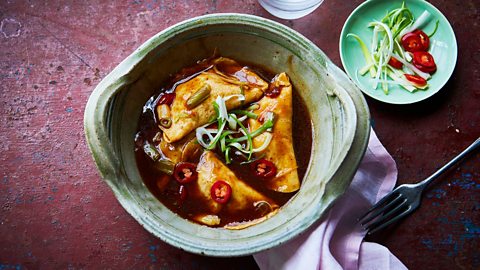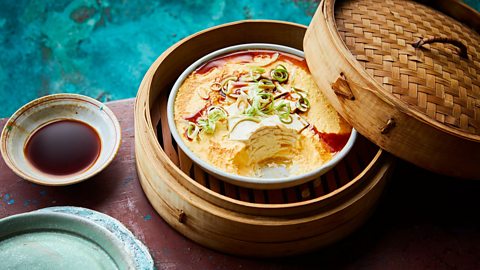How to make delicious Chinese food on a budget
by Jeremy Pang
Almost 20 years ago, I turned up at university with a wok and a bag of rice. I also had a small box containing light and dark soy sauce, sesame oil, sugar (for tea, and to satisfy the Chinese belief that a pinch accentuates the sweetness of everything we cook) and eggs. My friends and I look back fondly at the dishes we cooked with these few ingredients. Having just packed for a staycation, a box of dry ingredients is in the car â it is very similar to that student box â and Iâll buy the eggs from honesty boxes.
Chinese family kitchens are traditionally very small. In Hong Kong and China, most are barely big enough to fit an oven in. Consequently people are resourceful and efficient. But the humble egg is a key item in almost every household, and one of the secrets to budget cooking. Iâve included recipes here to show how to stir-fry, steam and braise them, using ingredients you are likely to have in your fridge at some point, and leftovers.
Master simple cooking techniques
If youâve ever wondered how Chinese restaurants and takeaways create menus with hundreds of dishes on them, itâs down to this resourceful cooking. Once youâve mastered a few techniques, you can cook with a huge amount of variation using a handful of ingredients local to you. Itâs easier than you think.
To most people, it all starts with a wok and stir-frying. Yet the other skills â steaming, braising, deep-frying, poaching, roasting and double-cooking (piecing together two or more of any of the techniques) â help create the balance of texture in our food. A balance of flavour, texture and colour, and textural differences within a dish or meal, are incredibly important to Chinese cooking.
If you bite into a dumpling for example, the pastry may initially be soft but with an al dente bite, while the meaty filling should offer a little savoury resistance and add juiciness, and any vegetables inside will bring crunch. And if the dumpling were a pot sticker, Iâm sure we all share that moreish feeling of the crunch we get from that crispy base. You might say itâs all about that base, but I say never forget the rest â itâs the perfect balance of flavour, texture and colour that makes you want to pick up a dumpling and immediately go for next, and then guard the plate from anyone around you.
Chinese ingredients you shouldnât be without
Fresh ingredients such as ginger, garlic, spring onions, chillies, and coriander for those who enjoy it, are all essential components of Chinese cooking. All these ingredients are cheap, cheerful, and last a long time when stored properly. I tend to prepare them in different ways.
When it comes to the Chinese storecupboard, donât over-complicate it. Start with jasmine rice (in Chinese tradition, rice symbolises a heavenly link between the gods and earth and so should always be in abundance in your cupboard). Add dried noodles, light and dark soy sauce, pure sesame oil, oyster sauce, a good chilli paste or Chinese chilli oil, and hoisin sauce for good measure. The sauces, used in the right quantities, provide the balance of flavour you need for a versatile selection of dishes.
The way you prep and cook all these ingredients, the amount you add, and the time you add them to the heat, can change their flavour.
Make the most of the humble egg
The egg is one of the few ingredients that is an essential part of most cuisines, and perhaps for this reason it is sometimes taken for granted. It can sit bold and bright, yet soft and oozing, on top of a noodle soup, and out-shadow everything else in that bowl just because it oozes so perfectly with its golden yolk. And eggs can work well with leftovers.
Eggs can be the driver of flavour for a dish, such as in western pancakes or steamed egg custards. They can be used as a vehicle for other ingredients, like in an omelette. Or they work well as the âglueâ that binds things together, for instance for a posh panko breadcrumb coating. They can even hold up a cake, while providing a savoury base flavour that balances the sweetness.


